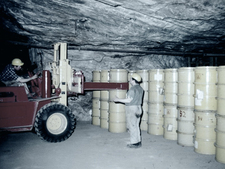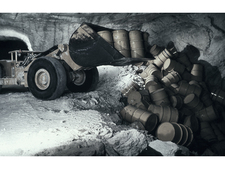Radioactive waste in Asse mine
What has been stored in the mine and where does it come from?
- 125,787 drums with radioactive waste were emplaced in the Asse II mine.
- More than 85% of the total activity stored in Asse II originate from the facilities of today's nuclear power plant operators.
- There are uncertainties as the emplaced waste were stated correctly.

![]() Storage of drums containing radioactive waste in an upright position (1967)
Storage of drums containing radioactive waste in an upright position (1967)
According to the former operator HMGU, 125,787 drums containing low-level and intermediate-level radioactive waste were emplaced in altogether 13 chambers of the Asse II mine between 1967 and 1978. Two chambers are located in the middle part and ten in the southern flank of the mine in a depth of 725 m to 750 m below the earth's surface. Between 1972 and 1977, exclusively medium-level radioactive waste was emplaced in a chamber lying in a depth of 511 m.
The major part of the waste originates from the operation of nuclear facilities and, to a small extent, from the application of radioactive substances in research, industry and medicine. Typical waste consists of filters, scrap, liquids, slugs or mixed waste.
Where the radioactive waste in Asse II comes from
The by far largest part of the circa 47,000 cubic metres of radioactive waste originates from the facilities of today's nuclear power plant operators Eon, Vattenfall Europe, RWE and EnBW. In 2015 the total activity amounted to approximately 2,400,000 gigabecquerel (1 gigabecquerel equals 1 billion becquerel).
With the help of documents one can more or less reconstruct how many drums were delivered to Asse between 1967 and 1978 that came from the nuclear power plants. It has also been documented how many waste packages originate from other institutions such as research institutes, medico-biological laboratories or from the Federal Armed Forces.
Apart from direct delivery to Asse II, large amounts of radioactive waste also came into the repository from nuclear power plants via the Karlsruhe Research Center. The local reprocessing plant which served as a pilot plant for the planned commercial Wackersdorf reprocessing plant accepted spent fuel elements from the German nuclear power plants. Combining the direct and indirect way, referred to 1980, this would result in more than 85% of the total activity stored in Asse II originating from the facilities of today’s nuclear power plant operators.
However, there are uncertainties as to whether the radionuclide inventory and the inventory of substances of the emplaced waste were stated correctly at that time. The Geesthacht federal state collecting depot gave some clues as to this. There waste packages had to be repacked in 2000 that had originally been intended to be disposed of in the Asse mine. Part of these waste packages was rusty and no more tight. When this waste was repacked it was detected that part of the radioactive waste had not been conditioned according to specification (e.g. immobilised with concrete). For some drums containing shielding containers the activity of the drum content had been determined wrongly and been declared too low due to the reduced dose rate at the outer surface of the drums. The waste declaration does not correspond to today's standards and was partially incomplete and incorrect. This concerned altogether 22 out of 155 drums examined in Geesthacht. The BfS needs therefore to be prepared that possibly also waste incorrectly declared was emplaced in the Asse mine.


